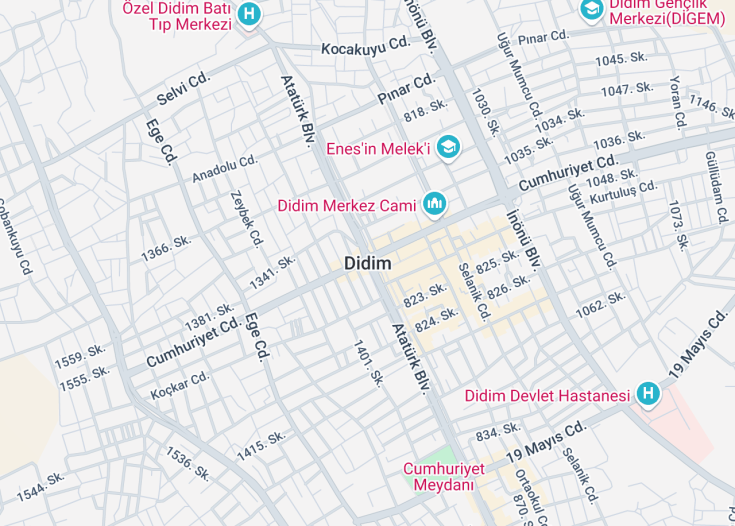Didim, a captivating destination in Turkey, offers a unique blend of ancient history and serene beach resorts. Known for its proximity to the Temple of Apollo, one of the most significant sanctuaries from antiquity, and its beautiful golden beaches, Didim attracts both history enthusiasts and sun-seekers.
The region is also famed for its olive groves and vibrant local markets, providing a peaceful yet culturally rich escape for visitors. Whether interested in exploring historic ruins or enjoying the scenic views of the Aegean Sea, Didim provides a diverse and enriching experience.
When visiting Didim, ensure to check out the weekly markets for authentic Turkish delights and handicrafts. It’s a wonderful way to experience local culture and flavors.
Plan a visit to the Temple of Apollo either early in the morning or late in the afternoon to avoid the crowds and relish the site’s majestic aura in quietude.
Top things to do & see in Didim
Select the following sights and activities to discover best tickets and tours available in Didim.
Didim: A Sun-Drenched Haven
| Country | Turkey |
| Time in Didim | GMT+3 |
| Language spoken | Turkish |
| Population | 30,674 (source: The local government census 2021) |
| Currency | Turkish Lira (₺, TRY) |
| Airports |
|
Didim, a coastal town in Turkey, merges the remnants of the ancient world with contemporary resort luxury. Historically known as Didyma, this coastal town was an important sacred site for the ancient Greeks, housing the famed Temple of Apollo.
Today, Didim draws visitors not only for its historical allure but also for its splendid beaches and vibrant nightlife. The transition from a vital ancient oracle to a modern-day holiday hub makes Didim a unique place that bridges eras, inviting travelers to delve into antiquity while enjoying the comforts of the present day.
Where is Didim?
Situated on the Aegean coast of Turkey, Didim is conveniently nestled between the cities of Bodrum and Izmir.
Distances:
| Route | Distance by car | Time by car |
|---|---|---|
| Istanbul to Didim | 374 mi / 602 km | Approx. 7 hours |
| Ankara to Didim | 404 mi / 650 km | Approx. 6 hours 30 minutes |
| Izmir to Didim | 87 mi / 140 km | Approx. 1 hour 30 minutes |
What is Didim famous for?
Didim is renowned for its beautiful beaches, the historical Temple of Apollo, and its proximity to the Greek sanctuary of Didyma. The area is a popular spot for tourists seeking both relaxation and a touch of historical exploration.
History
The history of Didim, a prominent city located in western Turkey, encompasses a fascinating journey through ancient civilizations, influential empires, and modern developments.
Ancient Times (Before 500 BC)
Didim’s history dates back to antiquity when it was known as Didyma. The area was famed for the Temple of Apollo, one of the most sacred places of prophecy in the ancient Greek world, akin to Delphi and Dodona. This sanctuary attracted not only pilgrims but also significant patronage from the rulers of the time.
Classical and Hellenistic Periods (500 BC – 323 BC)
During the classical and Hellenistic periods, Didyma thrived under the influence of the Ionian League and later the Persians. The city’s culture and architecture were epitomized by the monumental rebuilding of the Temple of Apollo, initiated around 334 BC by the architects Paionios of Ephesus and Daphnis of Miletus.
Roman and Byzantine Eras (323 BC – 1453 AD)
The conquests of Alexander the Great brought Didyma into the Hellenistic kingdoms’ dominion, and subsequently, the Roman Empire took control, marking a prolonged period of peace known as the Pax Romana, which facilitated further development. Under Byzantine rule, the region’s significance waned, yet maintained a connection to the religious and cultural shifts that swept across the empire.
Ottoman Rule (1453 – 1922)
Following the fall of Constantinople, Didyma, known then by its Turkish name Didim, became part of the expansive Ottoman Empire. During this era, it was more of a modest village involved in agriculture and fishing rather than the cultural beacon it was in antiquity.
Modern Period (1923 – Present)
In the aftermath of the Turkish War of Independence, the modern Republic of Turkey was established, and with it, Didim began to evolve into a notable tourist destination. The twentieth and twenty-first centuries have seen considerable investment in infrastructure, with the development of resorts, restoration of historical sites, and improvements in local amenities, showcasing Didim’s blend of historical allure and modern comfort.
Visit Didim
What to see and do in Didim, Turkey
Didim offers a rich tapestry of attractions, from ancient ruins to scenic beaches. Key sights include:
- The Temple of Apollo: Explore the remnants of this key ancient sanctuary.
- Altinkum Beach: Famous for its golden sands and crystal-clear waters, ideal for sunbathing and swimming.
- Aegean boat tours: Set sail to discover the stunning coastline and nearby islands.
- Didymaion: Delve into this ancient sanctuary dedicated to Zeus.
Events in Didim
Didim is host to an array of events that mark its cultural calendar. Noteworthy events include the Didim Peace Festival in August, celebrating local and international music, art, and cuisine; and the Annual Fishing Tournament in September, drawing anglers from across the globe.
Best time to visit Didim
The ideal time to visit Didim is during the spring (April to June) and early autumn (September and October), when the weather is pleasantly warm, and the tourist crowds are fewer, providing a more relaxed experience.
Is Didim worth visiting?
Didim is undoubtedly worth visiting for its unique combination of ancient history, beautiful landscapes, and vibrant cultural events. Whether you’re an enthusiast of archaeological sites, a lover of the seaside, or a participant in local festivities, Didim offers a compelling experience that blends the old with the new in a stunning Aegean setting.









